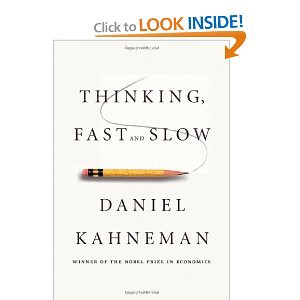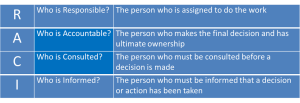My father used to tell me that the biggest problem he always experienced in business was that no one could make a decision. After graduating from The Wharton School at The University of Pennsylvania in 1948, Dad worked in his career at Bamberger’s Department Store, Creed Taylor Record Label, Triangle Industries, Rowe International and later as a financial planner with Merrill Lynch. It has taken me many years to understand the gem of insight and to figure out ways to be an even more effective marketing leader within the company I work for in North Carolina. I am always thankful I decided to choose Jack as my Dad in 1954 when I came into the world.
 Last week I started reading a fascinating book on how the brain works called Thinking Fast and Slow by Daniel Kahneman that has really started my wheels turning. In his book, Kahneman describes the two systems in the brain that drive the way we think- System 1 is fast (intuitive/emotional) and System 2 is slow (deliberate and logical). The book has me challenging and questioning how we make decisions and choices. More on this book in a future review but to learn more, click this link on Amazon.
Last week I started reading a fascinating book on how the brain works called Thinking Fast and Slow by Daniel Kahneman that has really started my wheels turning. In his book, Kahneman describes the two systems in the brain that drive the way we think- System 1 is fast (intuitive/emotional) and System 2 is slow (deliberate and logical). The book has me challenging and questioning how we make decisions and choices. More on this book in a future review but to learn more, click this link on Amazon. Since my background and experience bridges both the small, entrepreneurial world, mid-sized firms and large corporations, I thought I would share some observations and mention a few things I have learned along my yellow brick marketing road. As mentioned in an earlier blog post, I made lots of wonderful, productive mistakes that I think I have a few useful insights that might help guide you on this tricky terrain.
Who Decides? Decision making exists to help grease the wheels of day to day activities. There is a handy little guideline you can use when thinking about these issues called RACI. It is an acronym that helps you think about 4 categories within a decision making process.
RACI charts work great for most lower level decisions or typical projects that don’t involve huge capital investments or highly strategic activities. You could use this to help a team make a decision about a change on packaging, use of a new supplier or instituting a new software program. This guideline helps when the dollars impact isn’t major and the strategic importance is modest or small to the business.
But big decisions are harder to manage and this is what my Dad was alluding to in his comments that he shared with me many years ago. How can a mid-sized or large firm do a better job of efficiently and effortlessly make good decisions in a timely fashion?
The quick and simple way to think of this is that the leaders of the company set the rules. Imagine they are the governing board and helping you understand the rules of engagement. A sports metaphor makes this clear. The senior managers have to help everyone else play the game. So, if your leadership defines how a game is played (like football), you understand how to score, when penalties occur, how long the game is, what role and responsibilities the referees have, etc. The rules define where the authority lies for a major strategic decisions. Is it with an individual or a group who collaborate? It is helpful for the associates to be clear where this decision making authority exists so that no one is blind-sided by not including the right individuals in the process. Back to my sports metaphor, the staff is going to play the game- without setting these rules, chaos reigns and sometimes decisions are made based on who has the loudest megaphone or power base.
The following are a few ideas to help you think about these issues:
Start at the Top It always helps to start at the top. The CEO/President/Owner is going to want to be involved in the most important decisions. The best advice is spell it out clearly with examples. So perhaps your leader wants to be the final decision maker if you have a project that involves X amount of dollars. Perhaps she wants to make decisions that she deems highly strategic like involving the switch to a new technology platform, changing a major vendor or even the decision to alter the deal/pricing structure with a top 10 customer. Define it. Share it. Make it clear. Tell everyone in a simple document what decisions you own. Of course you will consult with many others and you may not execute the decision. But make it clear that you own it and are truly accountable for the final decision.
Work Your Way Down the Food Chain to VP’s Once it is clear what the CEO deems to be the top issues, then the next level down can do the same exercise. Perhaps you have a group of VP who has departmental responsibilities. Define what each person can determine by themselves versus when they need to collaborate on a decision. Give a handful of clear examples for each person. What is the VP of Sales decision making authority? When does he get to make the call versus collaborate with his peers? When does he have to push it up to the CEO? With just a few examples, it quickly becomes clear how much authority is empowered in each individual VP versus them as a collaborative team.
Next Stop – The Directors Next, go down a level to the Directors or the next band of management. Do exactly the same exercise as the VP’s. Give a few key examples for each Director when they can act unilaterally versus with the collaboration of their peers. Generally speaking, you don’t have to go deeper than this into the organization. In a company with 1000 employees, often it just takes about 20 senior managers whose decision making authority needs to be clear to everyone.
Publish a matrix or chart that illustrates what has been decided. Be transparent and share this internally so everyone is clear. Most of the major conflicts will be avoided and decision making authority will be more obvious to all.
I’m glad I decided to write this post. You can hold me accountable.






